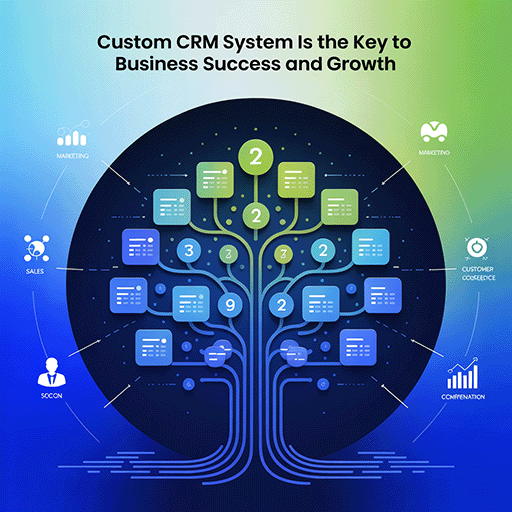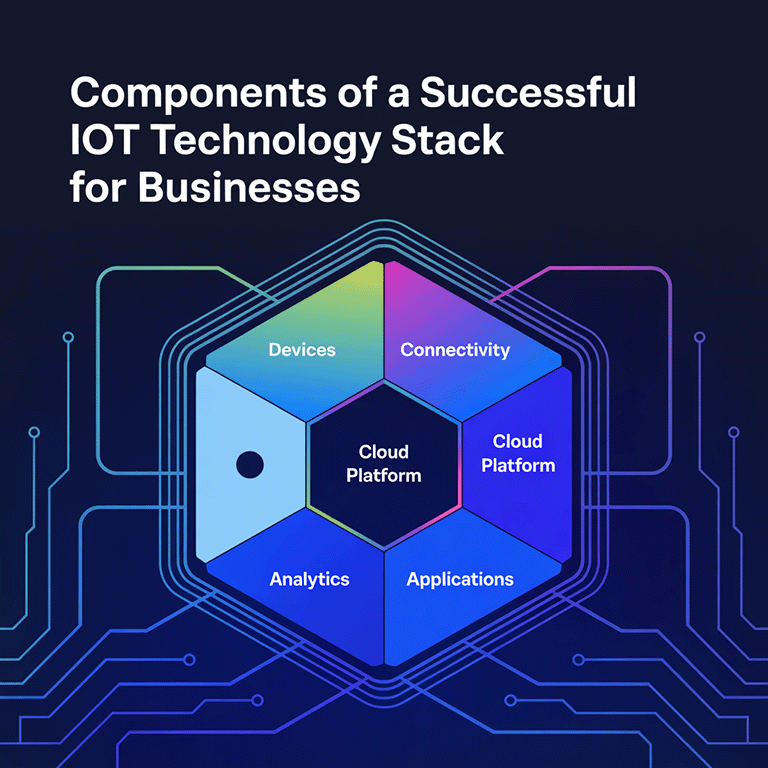Mobile apps are crucial tools for increasing revenue, improving business efficiency, and engaging customers in today’s digitally first world.
The way that contemporary users interact with digital platforms is greatly influenced by recommendation systems. From Amazon suggesting your next must-have item to Spotify curating your music preferences, these clever systems produce tailored experiences that increase engagement, boost revenue, and foster brand loyalty.
This article will teach you how to create a recommendation system using machine learning, focusing on real-world implementation. Every stage of the procedure will be covered, including data collection, algorithm selection, training, evaluation, deployment, and iteration. This pragmatic approach will assist you in creating intelligent, scalable ML recommendation engines that support your business objectives, whether you’re starting a new company, optimising an e-commerce store, or improving a media platform.
Providing customised user experiences has evolved from a luxury to a necessity as companies compete in more and more cutthroat markets. Machine learning-powered recommendation systems serve as silent salespeople, assisting users in making choices that suit their preferences while also expediting the process of finding content. These systems improve customer satisfaction, lower attrition, and promote long-term growth in a variety of sectors, from retail and entertainment to education and healthcare, by analysing user behaviour and making adjustments in real time.
What is a Recommendation System Machine Learning?
An algorithmic engine that filters and displays products or content for specific users based on their demographics, preferences, or behaviour is called a recommendation system. These recommender systems are developed with machine learning, and as they process more data over time, they get better.
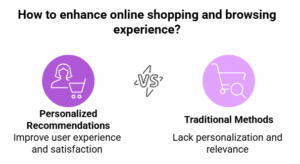
Recommendation systems are based on various models. Some rely on collaborative filtering, which contrasts items or users according to previous exchanges. Others use content-based filtering, which examines the characteristics of the actual items. Hybrid models, which combine several approaches to optimise accuracy and manage constraints like sparse data or new-user scenarios, are being used more and more.
The question of how recommendation algorithms operate is addressed by these systems. See our article on the foundations of machine learning for more information on algorithm types.
How Do Recommendation Systems’ ML Work?
When you browse or shop online, the website might suggest similar items — that’s the work of a product recommendation system powered by machine learning. This system learns from your previous actions — what you viewed, purchased, or searched for. It also compares your behavior with that of other users who have similar interests. For example, if many users buy shoes and then go on to purchase socks, the system might recommend socks to you, too.
An ML recommendation engine uses artificial intelligence to predict what you will enjoy. It remembers the products or movies you’ve liked and tries to find related ones. It also checks the features of items, like color, size, or style, to offer better suggestions.
Here’s how it usually works:
- You search for or buy something
- The system stores this data
- It analyzes your actions and preferences
- Then it recommends similar or trending products
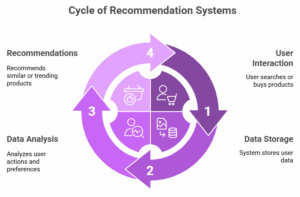
Over time, the ML recommendation engine becomes smarter as it gathers more data about you and other users. These systems save you time and help you discover what you want, often before you know you need them.
Why Use Machine Learning to Create a Recommendation System?
Including recommendation engines in your digital product makes perfect sense from a business standpoint. User engagement, retention, and revenue are frequently significantly increased for businesses using generative AI personalization to deliver smarter personalized recommendations.
For instance, e-commerce platforms use machine learning for product recommendations to boost the average order value by showing customers relevant items they are more likely to buy. Similar strategies are used by streaming services to keep users interested by presenting them with content that appeals to them. ML is even being used by e-learning platforms and news apps to personalise reading and learning experiences.
These systems provide strategic benefits in addition to higher engagement. They create insights that guide product and marketing strategies, automate a portion of the user experience, and lessen the friction associated with content discovery. The long-term return on investment of these technologies is highlighted in our post on the advantages of machine learning for business.
Step-by-Step List to Build a Recommendation System Using Machine Learning
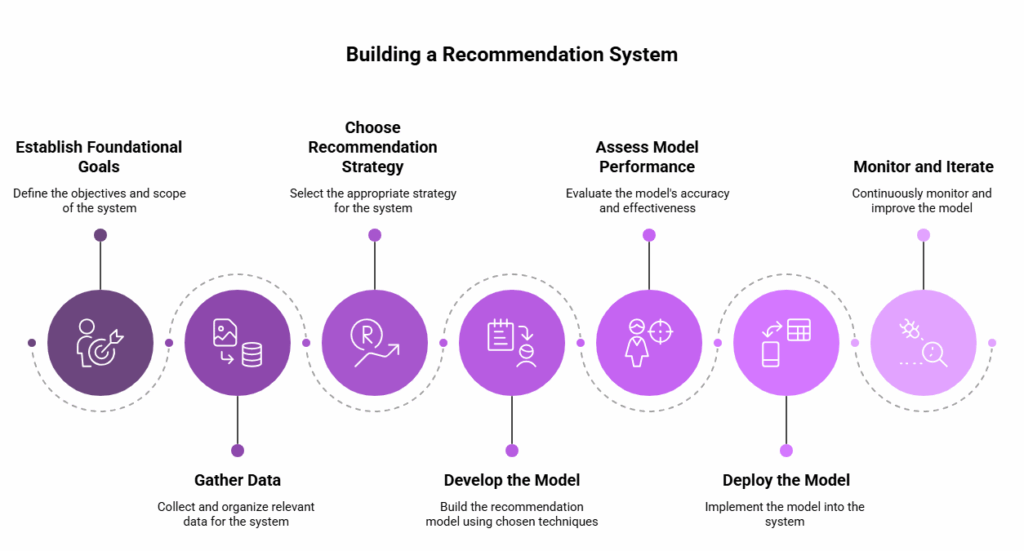
1. Establishing the Foundation: Gathering Information and Setting Goals
Before starting your machine learning project for a recommendation system, you must have a clear objective and high-quality data. Think about what success looks like and the specific products, media, courses, or content your system is recommending. Are you attempting to lower churn, boost sales, or increase user retention?
The next step after defining your goals is to collect the information that will drive your recommendation engine. This can include metadata like item descriptions, tags, and user demographics, as well as user-item interaction data like clicks, ratings, or past purchases.
The quality of the data is vital. Datasets that are sparse or inconsistent can seriously impair model performance. It is essential to spend time cleaning, preprocessing, and enriching your data because it forms the basis of an effective ML recommendation system.
2. Choosing the Right Recommendation Strategy
Selecting the machine learning strategy your system will employ is among the most crucial choices you will make. One of the most popular approaches is collaborative filtering. Finding trends in user behaviour, such as what comparable users liked or didn’t like, is how it operates.
Content-based filtering is another popular technique. This method matches items with user preferences by comparing them to one another based on their attributes. A user who reads a lot of articles about artificial intelligence, for instance, might be suggested additional articles with related keywords and subjects.
Then there are hybrid approaches, which build more resilient and adaptable recommendation systems by combining content-based and collaborative techniques. These models make up for each method’s shortcomings while utilising its advantages. Collaborative filtering, for example, is excellent at revealing hidden patterns in user behaviour, but it suffers from a lack of data, such as when dealing with newly added items or new users.
Conversely, content-based filtering may result in recommendations that are too specific, but it can offer instant suggestions based on item attributes. Even in the early phases of user engagement, hybrid systems can provide more varied and accurate recommendations by combining the two. Because of this, they are especially good at solving the “cold-start” problem, in which conventional models are unable to perform well because of a lack of historical data
3. Developing the Model: Instruments, Methods, and Procedures
It’s time to put theory into practice after deciding on your strategy. Because of its powerful libraries, including Scikit-learn, TensorFlow, PyTorch, and Surprise, Python is the most widely used language for creating machine learning recommendation systems.
Data preprocessing, which includes dividing the dataset into training and testing sets, normalising inputs, and encoding categorical variables, is the first step in the standard development process. After preparation, the model is trained with the algorithm of your choice. To enhance generalisation, this may entail adjusting hyperparameters, applying cross-validation, or adding regularisation.
It’s critical to keep an eye on your model’s performance and learning process during this phase. You will need to adjust the training configuration if your system is overfitting. Use a more sophisticated algorithm or add more features if it’s underfitting.
4. Assessing the Model’s Performance
You must use the appropriate metrics to assess the performance of your recommendation engine machine learning setup to determine whether it is truly effective. In real-world applications, where user experience and engagement are more important than flawless predictions, accuracy alone is insufficient.
The relevance of the recommendations is assessed using metrics such as precision, recall, and F1 score. Mean Average Precision (MAP) and Normalised Discounted Cumulative Gain (NDCG), two ranking-based metrics, evaluate whether the best items are displayed at the top of the list of recommendations.
Real user testing is important in addition to quantitative metrics. If a model’s recommendations are overly specific or repetitive, it may perform well on historical data but not engage users. Always include user-centric testing in addition to statistical evaluation.
5. Solving the Cold-Start Issue
The cold-start problem, which occurs when new users or items are added but the system does not yet have enough data to make trustworthy recommendations, is one of the largest challenges in developing recommendation systems.
Using hybrid recommendation models that combine behavioural and attribute-based signals is a clever solution to this problem. For instance, the system can suggest a newly added item to users whose profiles match its metadata. Similar to this, new user profiles can be initialised with the aid of onboarding questionnaires or brief preference surveys.
Temporary recommendations can also be made by incorporating session data and trending items until sufficient data is gathered. You can guarantee a more seamless user experience right away by taking proactive measures to address the cold-start issue.
6. Deployment and Integration Recommendation System ML
It’s time to launch your ML recommendation engine into production after it has been trained and verified. This entails selecting the appropriate infrastructure, integrating it with your platform, and configuring APIs to provide real-time recommendations.
AWS SageMaker, Google Cloud ML, or Microsoft Azure are a few examples of cloud machine learning services where you can host your model. These platforms provide automated retraining choices, monitoring tools, and scalable infrastructure. As an alternative, you can use Docker to create a containerised solution and use REST APIs to serve it.
At LITSLINK, we offer end-to-end ML development services, including custom model deployment and platform integration.
7. Monitoring and Iteration
The process doesn’t end with system deployment. As user behaviour evolves and new content is added, recommendation engines need to be updated frequently to stay effective.
Setting up feedback loops, usage analytics, and automated retraining pipelines is crucial. When determining which models or tuning techniques produce the best results, A/B testing can be especially helpful. Your iteration process should be guided by user feedback, whether it be direct (ratings) or indirect (click-through rates, bounce rates).
A recommendation system ought to change in tandem with your users.
Music Recommendation Systems using ML as a Real-World Example
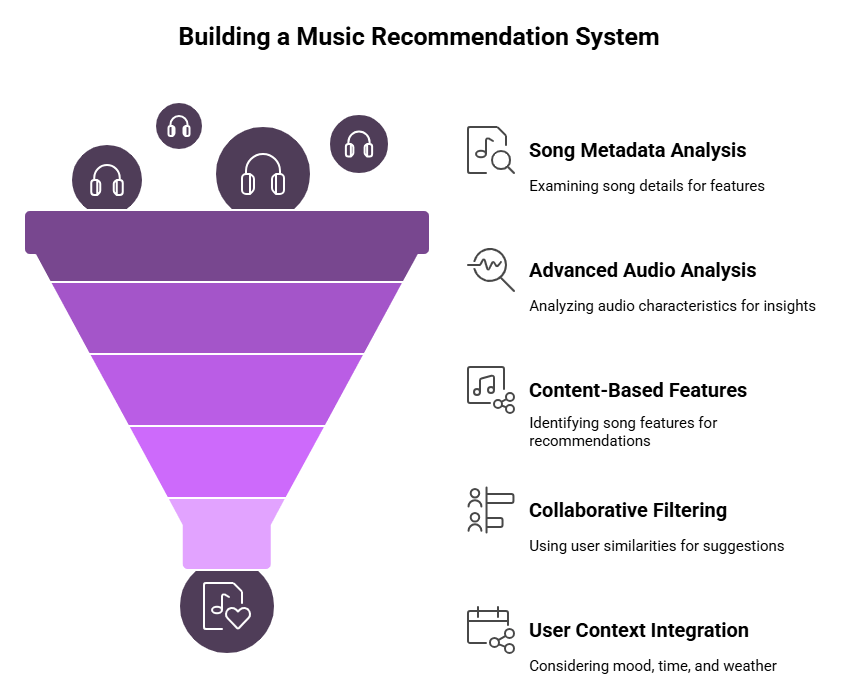
How can I build a music recommendation system using machine learning? The steps are similar to those for developing other recommendation systems, but they concentrate on features unique to a given medium.
User listening history, song metadata (genre, artist, tempo, mood), and perhaps even audio analysis tools like rhythm or pitch are required. Your system can provide genuinely customised playlists by combining content-based features with collaborative filtering, a tactic that YouTube Music and Spotify both employ.
You can increase listening time and further customise the experience by training models to recognise user mood, time of day, or even weather preferences.
Final Thoughts: Using ML to Create Business Value
Businesses can provide more intelligent, personalised, and engaging user experiences by learning how to build recommendation systems using machine learning. These systems have a direct impact on revenue, customer satisfaction, and retention in addition to improving usability.
Your ML recommendation system can be a significant growth tool if you have the correct data, a well-defined plan, and ongoing optimisation. Recommendation engines improve the intelligence and user-friendliness of your offering, whether you’re expanding your content platform, improving an app, or introducing a new product.


